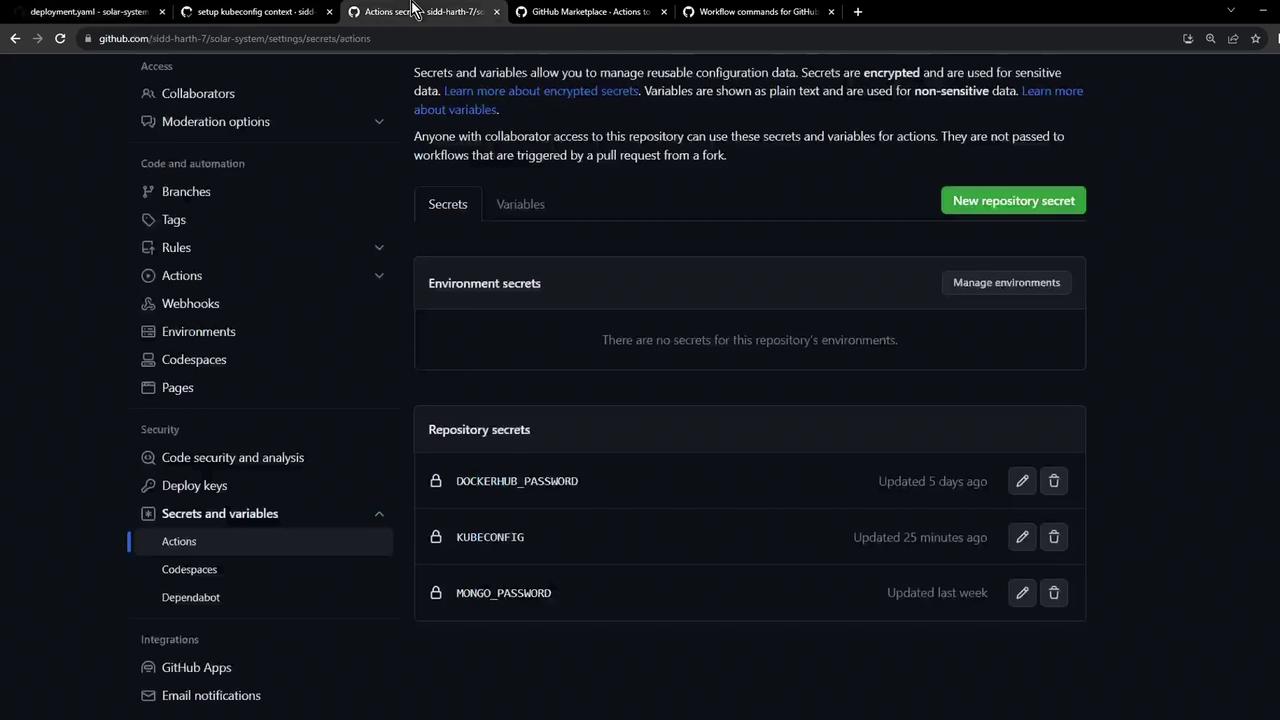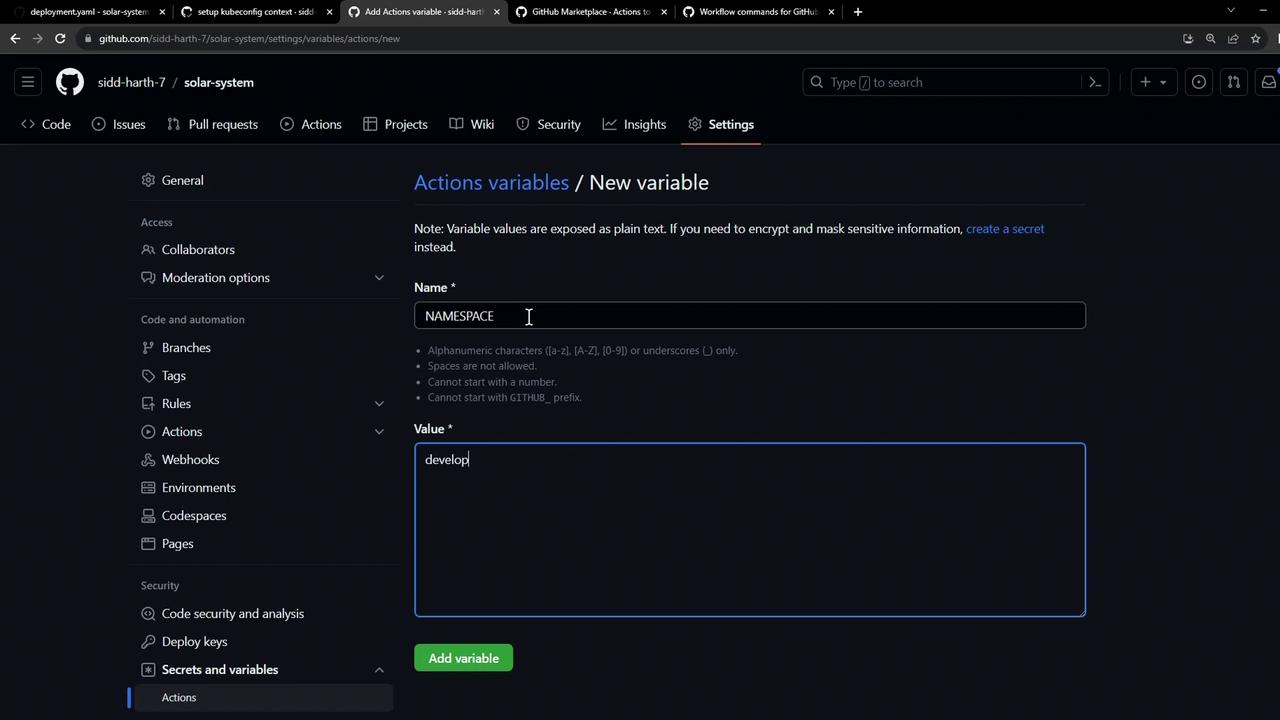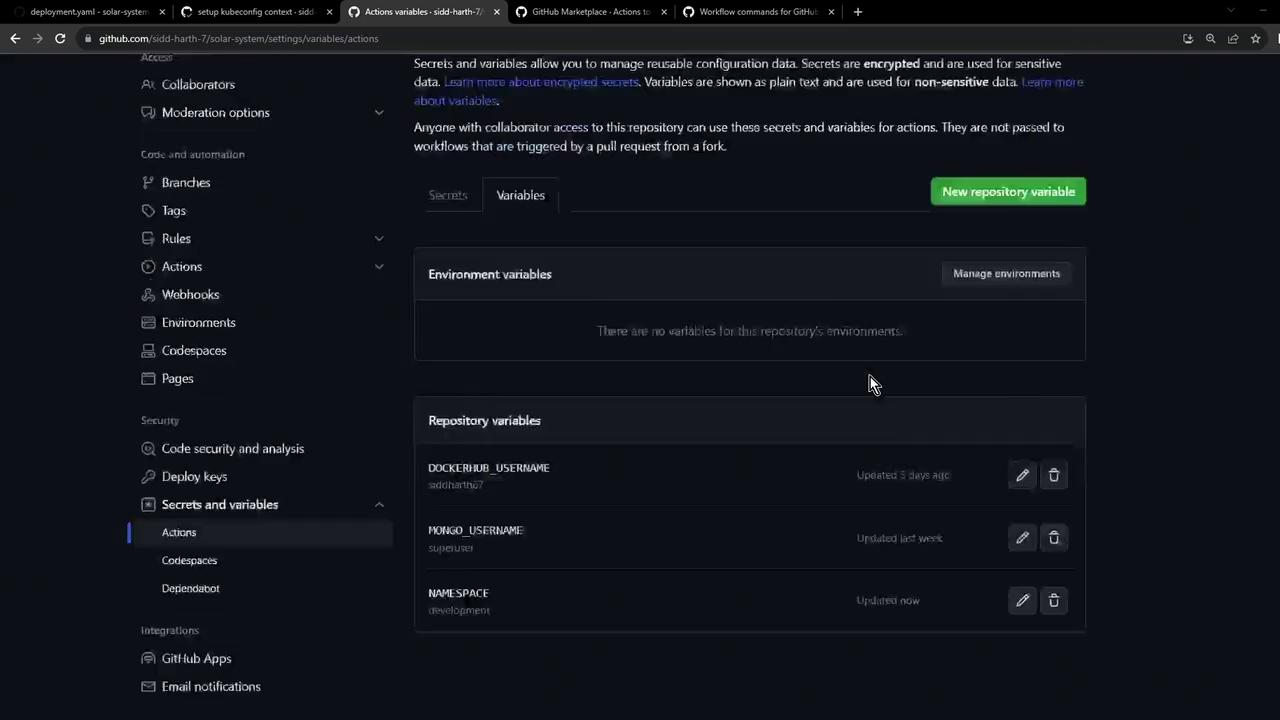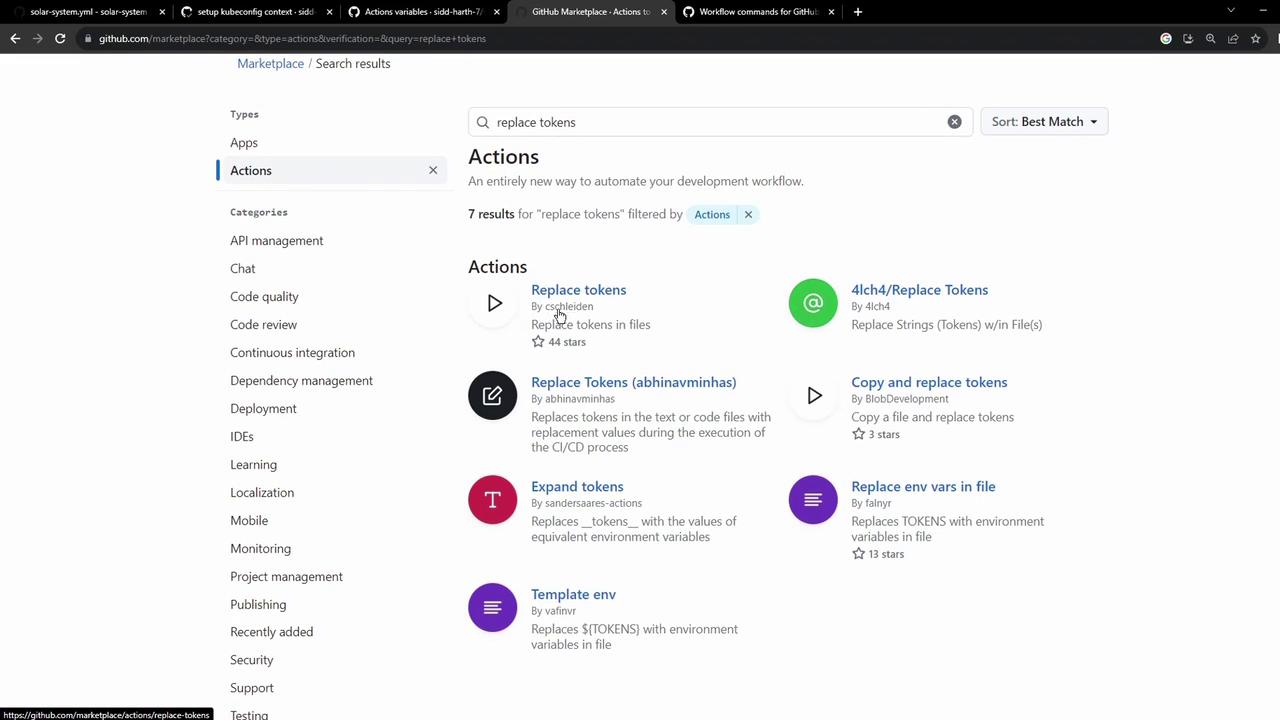GitHub Actions
Continuous Deployment with GitHub Actions
Workflow Replace Placeholders Tokens
In this guide, you’ll learn how to automate token replacement in your Kubernetes manifests using GitHub Actions. We will cover:
- Defining repository-level variables for namespace, replicas, and image
- Installing and configuring the
cschleiden/replace-tokens@v1action - Dynamically fetching the Ingress controller’s external IP
- Applying placeholder replacement in
kubernetes/development/*.yaml - Verifying the transformed manifests before deployment
Placeholder tokens in your manifests
Under kubernetes/development/, manifests contain tokens like {_NAMESPACE_}, {_REPLICAS_}, {_IMAGE_}, and {_INGRESS_IP_}:
# kubernetes/development/deployment.yaml
apiVersion: apps/v1
kind: Deployment
metadata:
name: solar-system
namespace: {_NAMESPACE_}
spec:
replicas: {_REPLICAS_}
selector:
matchLabels:
app: solar-system
template:
metadata:
labels:
app: solar-system
spec:
containers:
- name: solar-system
image: {_IMAGE_}
imagePullPolicy: Always
ports:
- containerPort: 3000
name: http
# kubernetes/development/service.yaml
apiVersion: v1
kind: Service
metadata:
name: solar-system
namespace: {_NAMESPACE_}
spec:
ports:
- port: 3000
targetPort: 3000
selector:
app: solar-system
# kubernetes/development/ingress.yaml
apiVersion: networking.k8s.io/v1
kind: Ingress
metadata:
name: solar-system
namespace: {_NAMESPACE_}
annotations:
kubernetes.io/tls-acme: "true"
spec:
rules:
- host: solar-system-{_NAMESPACE_}.{_INGRESS_IP_}.nip.io
http:
paths:
- path: /
pathType: Prefix
backend:
service:
name: solar-system
port:
number: 3000
tls:
- hosts:
- solar-system-{_NAMESPACE_}.{_INGRESS_IP_}.nip.io
secretName: solar-system
All tokens must be replaced before applying these files to the cluster.
1. Define repository variables
Navigate to Settings > Secrets and variables > Actions in your GitHub repository. Here you can add both non-secret variables and secrets.

Note
Use Variables for non-sensitive configuration (e.g., NAMESPACE, REPLICAS) and Secrets for credentials (KUBECONFIG, DOCKERHUB_PASSWORD).
Add the following repository variables:
| Name | Value | Description |
|---|---|---|
| NAMESPACE | development | Kubernetes namespace for development |
| REPLICAS | 2 | Number of replicas to deploy |

Once added, your list should look like this:

Ensure you also have DOCKERHUB_USERNAME defined for constructing the container image reference:

2. Choose a token-replacement action
From the GitHub Marketplace, install cschleiden/replace-tokens@v1. This action will scan files and replace tokens based on your specified prefix and suffix.

Example configuration:
- uses: cschleiden/replace-tokens@v1
with:
tokenPrefix: '{_'
tokenSuffix: '_}'
files: 'kubernetes/development/*.yaml'
env:
NAMESPACE: ${{ vars.NAMESPACE }}
REPLICAS: ${{ vars.REPLICAS }}
IMAGE: ${{ vars.DOCKERHUB_USERNAME }}/solar-system:${{ github.sha }}
INGRESS_IP: ${{ env.INGRESS_IP }}
3. Fetch the Ingress IP dynamically
Hard-coding the external IP limits flexibility. Instead, retrieve it at runtime using kubectl and store it in GITHUB_ENV:
kubectl -n ingress-nginx get svc ingress-nginx-controller \
-o jsonpath="{.status.loadBalancer.ingress[0].ip}"
In your workflow, you’ll capture this value:
- name: Save NGINX Ingress Controller IP
id: save_ingress_ip
run: |
echo "INGRESS_IP=$(kubectl -n ingress-nginx \
get svc ingress-nginx-controller \
-o jsonpath='{.status.loadBalancer.ingress[0].ip}')" >> $GITHUB_ENV
4. Complete GitHub Actions workflow
Below is a full example workflow that ties everything together:
name: Dev Deploy
on:
push:
branches: [ main ]
jobs:
deploy:
runs-on: ubuntu-latest
steps:
- name: Checkout repository
uses: actions/checkout@v3
- name: Set Kubeconfig
uses: azure/k8s-set-context@v3
with:
method: kubeconfig
kubeconfig: ${{ secrets.KUBECONFIG }}
- name: Fetch Kubernetes cluster details
run: |
kubectl version --short
echo "----------------------------------------------"
kubectl get nodes
- name: Save NGINX Ingress Controller IP
id: save_ingress_ip
run: |
echo "INGRESS_IP=$(kubectl -n ingress-nginx \
get svc ingress-nginx-controller \
-o jsonpath='{.status.loadBalancer.ingress[0].ip}')" >> $GITHUB_ENV
- name: Replace tokens in Kubernetes manifests
uses: cschleiden/replace-tokens@v1
with:
tokenPrefix: '{_'
tokenSuffix: '_}'
files: 'kubernetes/development/*.yaml'
env:
NAMESPACE: ${{ vars.NAMESPACE }}
REPLICAS: ${{ vars.REPLICAS }}
IMAGE: ${{ vars.DOCKERHUB_USERNAME }}/solar-system:${{ github.sha }}
INGRESS_IP: ${{ env.INGRESS_IP }}
- name: Verify token replacement
run: |
echo "=== deployment.yaml ==="
cat kubernetes/development/deployment.yaml
echo "=== service.yaml ==="
cat kubernetes/development/service.yaml
echo "=== ingress.yaml ==="
cat kubernetes/development/ingress.yaml
5. Outcome
After the workflow completes:
namespacewill be set todevelopmentreplicasupdated to2imageresolved as<your-dockerhub-username>/solar-system:<commit-sha>- Ingress host entries generated with the actual load balancer IP
This pattern can be replicated for other environments (e.g., kubernetes/production/) by adjusting repository variables and glob patterns in the workflow.
Links and References
Watch Video
Watch video content